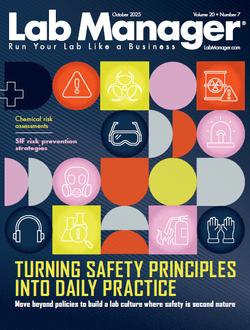Investing in Lab Work Without Burning Out

Marie-Colombe Afota is a professor in Université de Montréal’s School of Industrial Relations
UdeM
In high-performance lab environments, passion and dedication are often worn as badges of honor. But when does commitment cross into over-investment, leading to burnout and declining mental health? As lab managers and scientific professionals navigate digital workflows, remote collaboration, and demanding metrics, understanding the difference between healthy work engagement and toxic workaholism is essential.
New research from Marie-Colombe Afota and her colleagues sheds light on how different self-concepts influence work behavior—and what this means for lab teams operating in a culture of overwork. Lab leaders can use these insights to foster engagement, promote work-life balance, and avoid the pitfalls of digital presenteeism.
Understanding the Three Types of Work Investment
A foundational takeaway from the study is that not all work dedication is the same. Afota and her co-authors identified three distinct forms of work investment:
- Toxic Over-Investment (Workaholism)
- Work Engagement
- Affective Organizational Commitment
These differ in origin, motivation, and mental health impact.
“Workaholism is defined as addiction to work, characterized by ‘constant internal pressure and obsessive thoughts focused on work-related tasks,’” according to Afota.
Workaholism stems from a need to prove worth, often to oneself or others, and is commonly driven by an individualistic self-concept. In contrast, work engagement is a positive psychological state marked by vigor, enthusiasm, and concentration, and often rooted in a collective self-concept—a sense of belonging to a group or organization.
Quick Comparison:
| Type of Investment | Key Traits | Mental Health Impact |
|---|---|---|
| Workaholism | Obsessive thoughts, internal pressure | Burnout, depression, work overload |
| Work Engagement | Vigor, enthusiasm, deep focus | Protective against burnout and depression |
| Affective Organizational Commitment | Emotional attachment to organization | No significant correlation with mental health |
Understanding these differences helps lab managers tailor policies that support productivity without compromising well-being.
Digital Presenteeism and the Remote Work Trap
The shift toward digitalization and remote work—especially post-COVID—has reshaped how lab professionals engage with their work. Expectations of being "always on" have blurred the boundaries between home and lab.
“With the spread of smartphones and email, the boundaries between personal and professional life have eroded over the past 15 years,” Afota said.
What many hoped would be a liberating move toward flexibility has in some cases worsened pressure and stress.
“Many teleworkers feel obligated to be available and responsive at all times to show they are productive and committed to the job.”
This phenomenon—digital presenteeism—can mislead managers into thinking high availability equals high performance. But Afota warns:
“Employers measure quantity, the amount of time spent working, but it’s a cognitive shortcut to conclude that if a person works a lot, they’re competent.”
For scientific professionals, whose tasks often require deep concentration and critical thinking, this misalignment can lead to fatigue, decreased innovation, and mental health challenges.
Recognizing the Mental Health Impact
Lab environments already come with stressors: tight deadlines, quality standards, regulatory compliance, and precise outputs. When workaholism enters the picture, it compounds the risk.
“Workaholism has only negative effects,” said Afota. “The data show that it leads to an increase in the number of hours worked, work overload and a risk of depression and emotional burnout.”
Work engagement, on the other hand, offers a protective buffer.
“Work engagement is not associated with work overload and protects against depression and burnout.”
This is a crucial insight for lab leadership. While long hours may seem like a badge of commitment, it is engagement, not overtime, that drives sustainable performance.
Rethinking Metrics and Management Practices
Afota emphasizes that common management practices may unintentionally reward harmful behavior.
“In a work landscape where the boundary between personal and professional life is increasingly porous, our results call for a rethink of management practices that value digital presenteeism and long working hours.”
Lab leaders must evolve beyond time-based metrics and instead focus on output quality, creative problem-solving, and team collaboration. The goal should be fostering conditions where scientists and technicians feel energized—not depleted.
“The quality of work engagement matters more than the quantity. More than ever, balancing dedication to the job with personal well-being is a subtle art that needs to be mastered.”
Actionable Roadmap: Preventing Burnout in Lab Environments
For Lab Managers and QA/QC Leads
Use this checklist to cultivate engagement while safeguarding team well-being:
Advanced Lab Management Certificate
The Advanced Lab Management certificate is more than training—it’s a professional advantage.
Gain critical skills and IACET-approved CEUs that make a measurable difference.
✅ Track output quality, not just time spent online or in the lab
✅ Encourage breaks and boundaries, especially for remote workers
✅ Train supervisors to recognize signs of burnout and toxic over-investment
✅ Support team identity to foster a healthy collective self-concept
✅ Discourage digital presenteeism by modeling off-hours disconnecting
✅ Offer mental health support and normalize conversations around well-being
✅ Redesign KPIs to prioritize creativity, innovation, and collaborative success
Conclusion: Building Sustainable Scientific Dedication
In high-stakes laboratory settings, dedication is essential—but it must be healthy, purposeful, and balanced. Afota’s research reveals the urgent need to distinguish between engaged employees and workaholics. While both may appear committed, only one approach supports long-term mental health, innovation, and sustainable lab success.
By shifting from measuring hours to supporting quality engagement, lab managers can foster a culture that values scientific excellence and employee well-being. In today’s digital world, learning to master that balance isn’t just smart—it’s vital.
Further Resources
- Frontiers in Psychology – Full Study
- Lab Manager: How to Keep Employees Engaged
- NIH Mental Health in the Workplace
- World Health Organization: Mental Health and Work
- American Psychological Association: Work-Life Balance
Let’s build labs that innovate with care—starting with how we work.
This content includes text that has been generated with the assistance of AI. For more information, view Lab Manager’s AI use policy.












